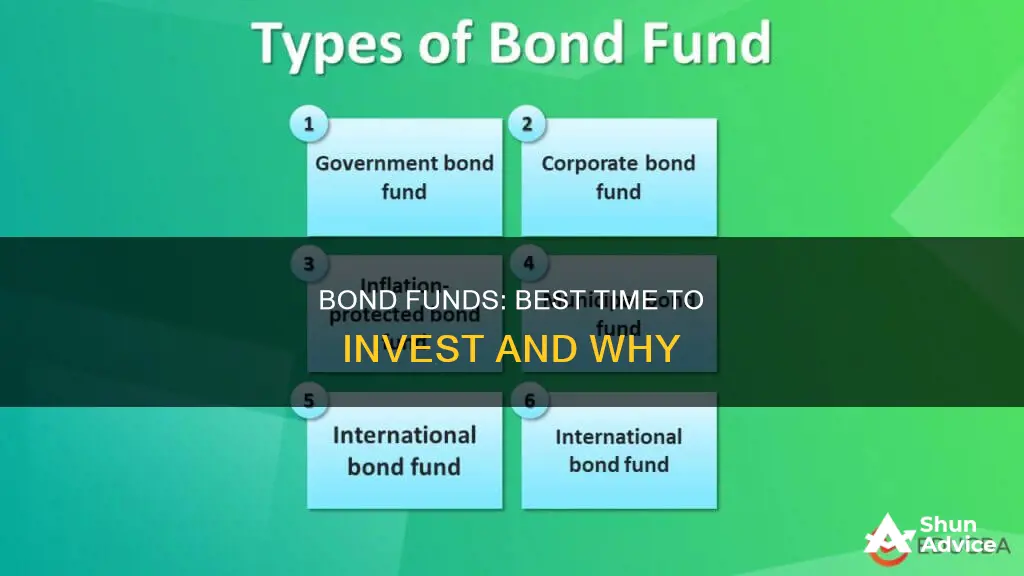
Bonds are a type of investment that can provide a steady rate of return and offset riskier investments such as stocks. They are considered safer than stocks but are not risk-free. The best time to invest in bond funds depends on your financial goals and investment strategy. If you are looking for reliable income, investing in bond funds when interest rates are high can be a good option as you can lock in higher coupon yields. On the other hand, if you are looking to diversify your portfolio, investing when interest rates are expected to decrease may be more favourable as it can lead to an increase in bond prices. It is important to remember that timing the bond market can be challenging, and maintaining the right allocation of bonds based on your investment goals and risk tolerance is crucial.
| Characteristics | Values |
|---|---|
| Interest rates | Currently high, likely to go down in the future |
| Bond yields | High |
| Bond prices | Likely to increase in the future |
| Bond funds | Can help investors diversify their bond exposure and target specific goals such as income, yield, or total return |
| Bond types | Treasury, corporate, mortgage-backed, high-yield, municipal, foreign, and emerging market |
| Bond maturities | Short-term, medium-term, and long-term |
| Bond risk | Credit risk, downgrade risk, interest rate risk, liquidity risk, inflation risk, call risk |
What You'll Learn

The pros and cons of investing in bond funds vs individual bonds
There are a few different views on when is the best time to invest in bond funds. Some sources suggest that the best time is when interest rates have peaked, as this can yield higher returns. However, others argue that rising interest rates reward investors who reinvest their principal over time. Therefore, the best time to invest in bond funds depends on the investor's individual goals and strategies.
Bond funds
Pros
- Bond funds are a great way to diversify your portfolio, especially for smaller investors.
- They offer broad market exposure and lower expense ratios.
- They are professionally managed, and the fund managers can make decisions based on huge volumes of information.
- They are an easy way to add a bond position to your portfolio.
- They are more liquid than individual bonds.
- They are less risky than individual bonds.
Cons
- There is no guarantee that fund investors will get their principal back.
- If interest rates rise, the fund's value falls, and investors may be forced to sell for less than they paid.
- Bond funds have expense ratios, which reduce overall returns.
Individual bonds
Pros
- Individual bonds are a buy-and-hold investment.
- They provide a steady rate of return and are a reliable source of fixed income.
- They are a good way to fund specific future goals, as the principal repayment can be timed to coincide with major expenses or purchases.
- They are less risky than stocks and have a low correlation with stocks, meaning their value is often up when stocks are down.
- They can protect a portfolio from an economic downturn, as falling inflation increases the purchasing power of future bond payments.
- They can be timed to take advantage of falling interest rates.
Cons
- Individual bonds require a considerable amount of wealth and expertise to build and manage a diversified portfolio.
- They are less liquid than bond funds, as there is a risk of not being able to find a buyer or get a fair price.
- They are more risky than bond funds, as there is a chance of the issuer defaulting.
- They are less tax-efficient than bond funds.
- They are less flexible than bond funds, as the money is tied up until the bond matures.
- They are more difficult to buy and sell than bond funds, often requiring the use of a financial advisor.
U.S.A.A. Mutual Funds: Where to Invest Wisely
You may want to see also

The risks of investing in bonds
While bonds are considered a safer investment option than stocks, they are not risk-free. Here are some of the risks associated with investing in bonds:
Credit Risk
The biggest risk to bond investors is that the issuer won't make timely payments, known as credit risk. The lower a bond's credit rating, the higher its credit risk. Credit rating agencies such as Moody's, Standard & Poor's, and Fitch rate bonds based on their overall risk, including the likelihood that the issuer will repay their debt in full and on time. Bonds with low credit ratings are considered more speculative and subject to more price volatility.
Downgrade Risk
A bond's default risk can change over its lifetime. Credit rating agencies routinely re-evaluate bond issues and may adjust their original rating. This creates downgrade risk, or the risk that your bond will be downgraded and potentially lose value as buyers react to the higher risk.
Interest Rate Risk
Rising interest rates can hurt long-term bondholders who can't wait for their bonds to mature. When interest rates increase, bond prices tend to fall. Bonds with longer maturities and lower coupon rates are more sensitive to interest rate risk.
Reinvestment Risk
When interest rates are declining, investors may have to reinvest their coupon income and principal at maturity at lower prevailing rates, resulting in lower returns.
Inflation Risk
Inflation reduces the purchasing power of your interest payments. If bond payments trail the rate of inflation, you will lose purchasing power. Inflation may also lead to higher interest rates, which negatively impact bond prices. Inflation-indexed bonds, such as Treasury Inflation Protection Securities (TIPS), are designed to protect investors from this risk.
Liquidity Risk
Liquidity risk refers to the possibility that investors may struggle to find a buyer when they want to sell their bonds and may be forced to sell at a significant discount. This risk is typically lower for government bonds than for corporate bonds due to the larger issue sizes of government bonds. However, the sovereign debt crisis has reduced the liquidity of government bonds issued by smaller European peripheral nations.
Callable Bonds and Call Risk
Callable bonds give the issuer the right to redeem the bond early by repaying the principal before the maturity date. Issuers often call bonds when interest rates fall so they can issue new bonds at lower rates. This may force bondholders to reinvest at lower rates, a risk known as call risk.
Other Risks
There are additional risks associated with specific types of bonds, such as legislative risk, event risk, prepayment risk, contraction risk, extension risk, negative convexity risk, and early amortization risk. These risks vary depending on the type of bond, the issuer, and market conditions.
Retirement Fund Investment: Choosing the Right Option
You may want to see also

How to reduce risk when investing in bonds
Investing in bonds is a great way to balance out the riskier investments in your portfolio, such as stocks. While bonds are considered a safer investment option, they are not entirely risk-free. Here are some ways to reduce the risk when investing in bonds:
Diversify Your Portfolio
One of the most effective ways to reduce investment risk is to diversify your portfolio across different asset classes, such as stocks, bonds, term deposits, savings accounts, and real estate. By spreading your investments, you reduce the impact of a loss in one area, as it is offset by gains in another. Diversification can be achieved by investing in various industries and types of bonds, such as investment-grade corporate bonds, mortgage-backed securities, and securities backed by consumer credit.
Know Your Investment Goals
Establishing clear financial goals will help guide your investment decisions. If you are saving for a short-term goal, such as a holiday, investing in low-risk options may be preferable. On the other hand, if you are planning for retirement over several decades, you may opt for higher-risk investments with potentially higher returns. Setting goals will also help you determine your risk tolerance and the types of bonds to invest in.
Monitor Your Investments Regularly
It is important to keep a close eye on your investments and review them regularly. Market conditions can change, and staying informed will help you make timely adjustments to your investment portfolio. Monitoring your investments can help you identify warning signs of a potential loss or take advantage of profitable opportunities.
Be Aware of Scams
Scams are becoming increasingly sophisticated, making it challenging to distinguish them from legitimate investment opportunities. To protect yourself, always research the company and the individuals involved. Ensure they have the appropriate licenses and registrations, and be cautious if they pressure you into making quick decisions or charge high fees.
Understand Bond Ratings and Creditworthiness
Before investing in a bond, assess its creditworthiness and default risk. Credit rating agencies such as Moody's, Standard & Poor's, and Fitch Ratings evaluate the likelihood of the issuer repaying their debt. Bonds with higher credit ratings are generally considered less risky, while those with lower ratings may carry a higher risk of default.
Consider a Bond Ladder
A bond ladder is a strategy where you invest in bonds with different maturity dates. For example, you might have bonds maturing in one, two, and three years. As each bond matures, you reinvest the proceeds in a new bond with the longest maturity date in your ladder. This approach creates a steady stream of income and helps manage the uncertainty of future interest rates.
Choose the Right Type of Bonds
The type of bonds you invest in should align with your financial goals and risk tolerance. High-yield bonds offer the potential for higher income but come with greater risks. On the other hand, Treasury bonds are considered very low risk but typically have lower returns. Municipal bonds, or "munis," offer tax advantages, while corporate bonds are generally reliable but do not offer the same level of safety as Treasury bonds.
Compare Bond Yields
When comparing bonds, use the yield to maturity to calculate the annual return you can expect if the bond is held to maturity. The yield to worst assumes the issuer uses unfavorable provisions, such as early redemption, to calculate the yield to maturity. For callable bonds, use the yield to call or the yield to worst to make comparisons.
Assess Your Bond Exposure
The amount of bonds in your portfolio should align with your financial goals, risk tolerance, and investment timeframe. Generally, younger investors have fewer bonds, while those approaching retirement may have more bonds to provide a steady income. Target-date funds can be a useful reference for determining an appropriate level of bond exposure.
Seek Professional Advice
Investing in bonds can be complex, and it may be beneficial to consult a financial advisor or broker. They can provide personalized advice based on your unique circumstances and goals. Additionally, consider using online tools and resources to research and compare different types of bonds and their associated risks and returns.
Dave Ramsey's Investment Strategy: Specific Fund Choices
You may want to see also

The best type of bonds to buy
There are three primary types of bonds: corporate, Treasury, and municipal bonds. Each type of bond has its own unique characteristics, and the best type of bond to buy will depend on your financial goals and risk tolerance. Here are some factors to consider when deciding which type of bond to invest in:
- Risk and return: Treasury bonds are considered the safest investment option, but they also offer relatively low returns. High-yield bonds, on the other hand, can provide higher returns but come with more risk.
- Tax implications: Municipal bonds, or "muni" bonds, are often exempt from federal and state income taxes, making them a tax-efficient investment option.
- Credit rating: The credit rating of a bond is an indication of the issuer's ability to repay their debt. Higher-rated bonds are generally considered less risky but offer lower returns, while lower-rated, non-investment-grade bonds are riskier but offer higher returns.
- Maturity: The maturity of a bond refers to how long it will take for the bond to reach its full value. Short-term bonds mature within three years, medium-term bonds in four to ten years, and long-term bonds in more than ten years. Long-term bonds typically offer higher returns but are also more risky due to the potential for interest rate changes during their lifetime.
- Coupon rate: The coupon rate is the interest rate that the issuer will pay to the bondholder. Higher coupon rates usually mean higher returns for the investor but may also come with more risk.
When deciding which type of bond to invest in, it's important to consider your financial goals, risk tolerance, and investment horizon. It's also crucial to diversify your bond portfolio to reduce risk and ensure a steady stream of income.
Vanguard Funds: Best Investment Options for Your Portfolio
You may want to see also

How much bond exposure is healthy for your portfolio
The amount of exposure to bonds in your portfolio depends on several factors, including your age, risk tolerance, and financial goals.
Age
A common rule of thumb is to allocate a percentage of your portfolio to bonds based on your age. For instance, if you are 40 years old, you may want to allocate 40% of your portfolio to bonds and the rest to stocks. However, this rule may not be suitable for everyone and should be tailored to individual circumstances. Younger investors typically have fewer bonds, while older investors may have more bonds to generate a steady, predictable income.
Risk tolerance
Bonds are considered a less risky investment than stocks, but they are not risk-free. There is credit risk, downgrade risk, interest rate risk, liquidity risk, and inflation risk associated with bonds. If you have a low-risk tolerance, you may want to allocate a larger portion of your portfolio to bonds.
Financial goals
If you are investing for the long term, such as for retirement, you may want to have a larger allocation of stocks in your portfolio, as they have the potential for higher returns. If you are investing for the short term or need steady income, bonds may be a better option.
Current market conditions
The state of the economy and the market can also impact the amount of exposure to bonds you should have. For example, during times of economic and political uncertainty, investors often seek the safety of bonds, which can drive up their price. On the other hand, when interest rates are low, bonds may not provide as attractive of a return, so investors may favour stocks.
Expert opinion
Financial experts generally recommend having some allocation to bonds in your portfolio, even if it is a small percentage. The exact allocation will depend on your unique circumstances and financial goals.
RIA Mutual Fund Investment: What's the Catch?
You may want to see also
Frequently asked questions
Bonds are a great way to create stability in your portfolio and offset riskier investments such as stocks. Bonds provide a steady rate of return and are a reliable source of fixed income, especially for retirees.
Bonds are best bought when interest rates are high and likely to decrease in the future. This is because the value of a bond is inversely related to the interest rate. So, when you buy a bond at a high-interest rate and the interest rate decreases, the value of your bond increases.
There are many types of bonds, including U.S. Treasury bonds, corporate bonds, mortgage bonds, high-yield bonds, municipal bonds, foreign bonds, and emerging market bonds. The type of bond you should invest in depends on your investment goals, tax exposure, risk tolerance, and time horizon.
You can invest in bonds by purchasing individual bonds or through bond funds/ETFs. Individual bonds can be bought directly from their issuers, but many retail investors use financial advisors. Bond funds and ETFs are a more accessible way for smaller investors to gain exposure to a diversified portfolio of bonds.
A bond ladder is a portfolio of bonds with different maturity dates. This strategy helps create a steady stream of income, reduce stock market volatility, and manage interest rate risks.







